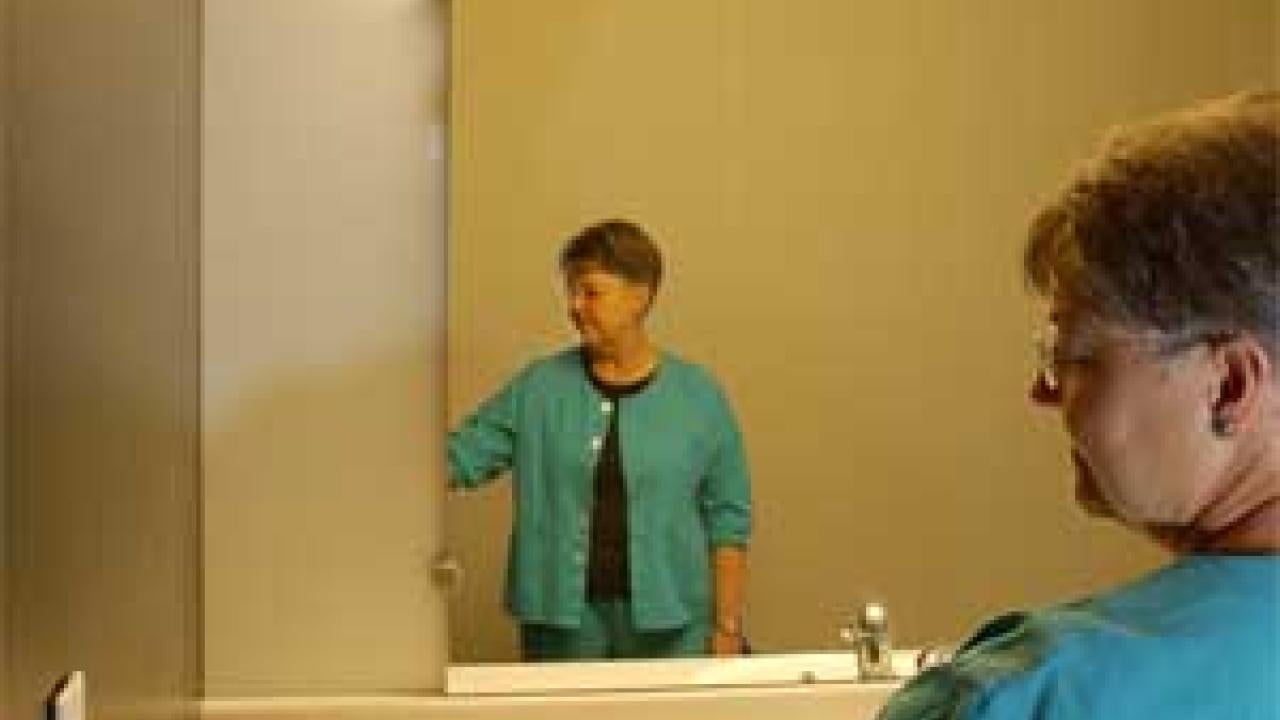A "smart" vanity lighting system developed at UC Davis promises to save substantially on energy costs and improve safety for an aging population with diminishing eyesight.
The new energy-saving light is the product of a partnership of the California Lighting Technology Center (a research and development program at UC Davis), the Sacramento Municipal Utility District, the California Energy Commission's Public Interest Energy Research Program, and two manufacturers, MetalOptics/SpecLight and The WattStopper Inc.
"We knew that this lighting system would promote better energy efficiency, lighting quality and comfort," said Michael Siminovitch, CLTC director and a professor of design, who has been designing more efficient lighting systems for the past two decades. "But it is also a product that improves health and safety, especially for seniors."
In fact, because this particular design is aimed at helping people navigate better in the dark to avoid accidents, Siminovitch believes the new vanity lighting system may be one of the most important inventions coming from his research lab in the next decade.
SMUD estimates the new system will save as much as 50 percent in energy consumption over standard bathroom vanity lighting systems, said Dave Bisbee, project manager for SMUD's Customer Advanced Technologies Program.
The new fixture includes energy-efficient fluorescent lighting, an integrated motion sensor and -- what makes it stand out -- a light-emitting diode night-light with battery backup that doubles as a safety light during power outages.
The LED night-light, which emits an orange glow that uses less than one watt of power, was designed to provide enough light to enable a person to safely navigate within a bathroom while preserving night vision.
Usually, when people turn on a bathroom light at night, their eyes take several minutes to adjust to the brightness. After they turn off the light and return to bed, their vision, adapted to the bright light, is impaired again for several minutes. Because the elderly take more time for their eyes to calibrate for darkness, they have even more problems negotiating through the dark.
UC Davis is in the process of filing a patent application for the vanity lighting system and is negotiating with manufacturing companies to license it. The cost for this new system is expected to be about $200, according to Bisbee.
Building on previous lighting inventions, Siminovitch and UC Davis Senior Development Engineer Erik Page developed nearly two dozen designs before settling on the final prototype last June. SMUD agreed to finance the installation and test of the efficiency of the new invention, and SpecLight and The WattStopper, a manufacturer based in Texas, agreed to create the prototype. The test product arrived in Sacramento in March for installation.
Since then, SMUD customers have been helping test the invention installed at the Red Lion Inn, Regency Place and Emerald Gardens in Sacramento.
JoAnn Smith, a retired nurse living at Regency Place, an assisted living facility, said she had found the new system to be quite useful.
"The night-light stays on all the time so I don't run into the door and can see to get a glass of water or whatever," she said.
By creating a product that offers night vision, CLTC and SMUD hope to help with what Rensselaer Polytechnic Institute's Lighting Research Center says is the No. 1 problem facing senior housing providers: tripping and falling by residents.
It should also help people who share hospital or hotel rooms get more sleep, since anyone using the bathroom need not turn on the bright light and wake others in the room, Siminovitch pointed out.
But the new bathroom fixture is also expected to provide substantial energy savings in hotels and motels, where the product is expected to be popular for both customers and the owners. The fluorescent light is connected to a motion sensor. After a certain amount of time with no motion in the room, adjustable to as long as an hour, the larger light will turn off, leaving the LED on for visibility.
"People go into the bathroom for a tissue and leave the light on accidentally -- for hours," co-developer Page said.
By installing the motion timer, hotels will save many kilowatt-hours per room, he said.
In fact, lighting accounts for nearly a fourth of the nation's electrical energy consumption. In California alone, lighting comprises almost 30 percent of commercial and 18 percent of residential electricity usage during peak demand.
In early 2004, UC Davis hired four lighting specialists including Siminovitch, Page and Konstantinos Papamichael, all formerly with the Lawrence Berkeley National Laboratory, to establish the CLTC, a teaching and research program that emphasizes energy-efficient lighting with market-friendly design.
The CLTC conducts both cooperative and independent activities with lighting manufacturers, electric utilities and the design/engineering professional community. These partnerships are assisted and supported through state-of-the-art lighting and day lighting applications and development/testing facilities, coupled with lighting-efficiency training and educational programs.
The UC Davis center was established as a collaborative effort between the California Energy Commission and UC Davis, with support by the U.S. Department of Energy, the National Electrical Manufacturers Association and California utilities. The Energy Commission's Public Interest Energy Research (PIER) Program and the UC Davis campus provided the initial funding.
Media Resources
Susanne Rockwell, Web and new media editor, (530) 752-2542, sgrockwell@ucdavis.edu
Chris Capra, SMUD Media Services, (916) 732-5111, ccapra@smud.org
